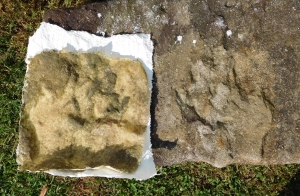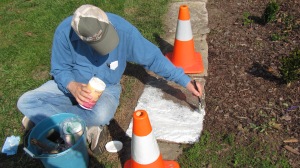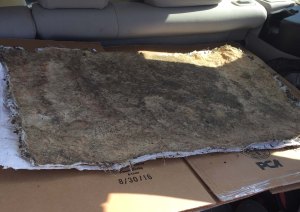Dr. Robert E. Weems, a retired research geologist with the United States Geological Survey, returned to Belmont in October to make four molds of some of the prints he discovered during a visit to Belmont during the summer of 2015. The prints he selected for mold-making were based on size, clarity and/or scientific interest. A large crocodile print was one of the molds made. Another large-sized specimen included for the study is a partial Brontopodus forefoot print. A partial print from a large bipedal predator, the Acrocanthosaurus, was also chosen for casting.

Hypsiloichnus mold and print
The smallest print selected for molding was Hypsiloichnus, which is the track made by a small herbivorous dinosaur similar or identical to Zephyrosaurus. See this link for more information about this dinosaur. https://en.wikipedia.org/wiki/Zephyrosaurus
Unfortunately, the crocodile print mold did not sufficiently dry before it was pulled up and thus failed to create an non-distorted copy of the foot shape. The other three print molds were successfully made. Dr. Weems will return next spring when the weather warms back up to try again to make a copy of the crocodile print, which is the best and largest crocodile print so far found in these rocks.

Dr. Weems applies the first layer of latex to a partial Brontopodus print.
The process of making the molds is quite involved and interesting. Three layers of latex were applied to clean stone, followed by two layers of cheese cloth and latex which was overlaid with a plastic barrier.

Cheese cloth adds strength to the latex mold.

Plaster of Paris strips are laid down over plastic to create a “cradle” for transporting the molds to the lab.
Plaster of Paris strips were laid down on the plastic to create a solid backing for the molds to prevent stretching and distortion. Each layer had to dry between applications making it a time consuming endeavor.
The molds were transported to Dr. Weems lab where they will be cast with plaster of Paris, creating exact copies of the prints. Eventually, the casts will be placed in the Smithsonian dinosaur print collection. Dr. Weems wants to make further studies of the Cretaceous period prints found in our garden paths and they may show up in future papers he hopes to write about Virginia dinosaur activity.

Transporting mold to lab for casting.
Emily Garrett, University of Mary Washington geography student is creating a map of the prints found in the stonework at Belmont. Look for this at the end of the fall 2016 semester!
